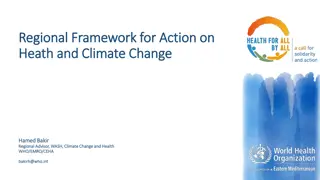Understanding Climate Change and Its Impacts
Climate change, a significant alteration in weather patterns over long periods, is primarily caused by natural factors such as variations in Earth's systems and human activities like deforestation and greenhouse gas emissions. This phenomenon leads to adverse effects on the environment, including melting glaciers, rising sea levels, and changes in ecosystems and weather patterns. The impact of climate change is far-reaching and requires urgent action to mitigate its consequences.
Download Presentation

Please find below an Image/Link to download the presentation.
The content on the website is provided AS IS for your information and personal use only. It may not be sold, licensed, or shared on other websites without obtaining consent from the author. Download presentation by click this link. If you encounter any issues during the download, it is possible that the publisher has removed the file from their server.
E N D
Presentation Transcript
Course e-Content Environmental Studies Climate Change IPCC UNFCCC
Climate Change Climate is an average weather condition of any place over long period of time. It can be analyzed by assessing the seasonal variations, patterns of temperature, rainfall, wind, atmospheric pressure, humidity and many other variables in an area. It takes a long time to change. Climate change can be defined as the significant change in weather patterns over long periods. Climate changes are connected with global warming, ozone layer depletion, acid rain etc. It is a periodic change in earth s climate due to the change in atmosphere as well as other factors like geological, biological, chemical etc within the earth s own system. Climate change causing many damaging and uncertain and more frequent events like hurricanes, floods, and cyclones etc. The temperature of earth rising continuously causing by climate change, the rate of melting of glaciers increases. It has devastating effect on coastline due to increased frequency of floods.
Causes of climate change: 1. Natural Causes: These include regional and global variation, volcanic eruption, and solar cycle, general circulation of ocean water, tectonic plate movement, and orbital variations. Due to these activities, the geographical condition of an area change and difficult for survival of life. These activities raise the temperature of the earth to a great extent and causing an imbalance in nature.
2. Anthropogenic Causes: Human activities causes tremendous increase in green house gases in the atmosphere. These gases absorb more heat and retain them for long time which has contributed for change in climate. Many plant and animal species go extinct due to human activity. Human activities that harm the climate include deforestation, using fossil fuel, industrial waste, a different type of pollution and many more. All these things damage the climate and ecosystem very badly.
Effects of Climate Change: These climatic changes have a negative impact on the environment. The following points can be noted as : Melting of Glaciers.: Rise in temperature causes polar ice sheets and glaciers to melt. Which causing sea level to rise resulting floods and erosion of coastal and low lying areas. Changes in Coastal areas : Increase in temperature causes devastating effect on the coastal areas. Due to this increase in temperature, the coral reefs are badly affected. Death of coral reefs will lead to death of many species that are dependent on it.
Effect on Ecosystem: Change in precipitation and temperature, due to climate change some species can no longer survive. Ecosystem change can be study in terms of abundance and distribution of species at globally. Changes in weather conditions: Heavy rainfall and other extreme weather events are becoming more frequent. Due to increase in temperature, the probability of extreme weather events such as Heat Waves, cyclones, hurricanes etc. are more frequent. Effect on economy: Increase frequency and intensity of cyclones and hurricanes causing damage to property and infrastructure annually across the globe.
IPCC The Intergovernmental Panel on Climate Change IPCC was created to provide policymakers with regular scientific assessments on climate change, its implications and potential future risks, as well as to put forward adaptation and mitigation options. The IPCC prepares comprehensive Assessment Reports about the state of scientific, technical and socio-economic knowledge on climate change, its impacts and future risks, and options for reducing the rate at which climate change is taking place. It also produces Special Reports on topics agreed to by its member governments, as well as Methodology Reports that provide guidelines for the preparation of greenhouse gas inventories.
UNFCCC The United Nations Framework Convention on Climate Change (UNFCCC) is an international environmental treaty adopted on 9 May 1992 and opened for signature at the Earth Summit in Rio de Janeiro from 3rd to 14th June 1992. It then entered into force on 21st March 1994. The objective of UNFCCC is to "stabilize greenhouse gas concentrations in the atmosphere at a level that would prevent dangerous anthropogenic interference with the climate system". India signed the UNFCCC on 10th June 1992 and ratified it on Nov 1993. It acceded to the KYOTO protocol in Aug, 2002. Under the UNFCCC, developing countries do not have binding greenhouse gas mitigation commitment through application of the principal of common but differentiated responsibility and respective capability.























